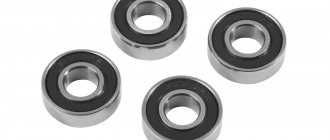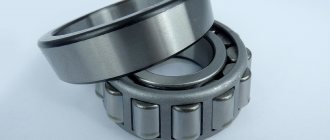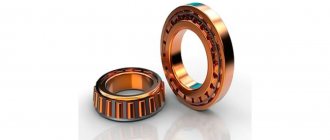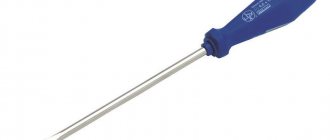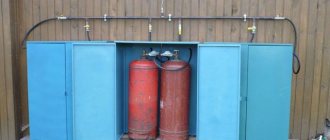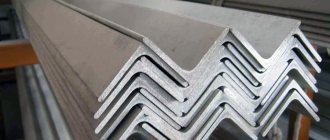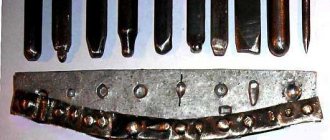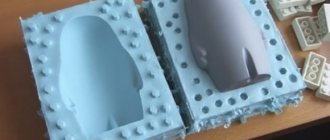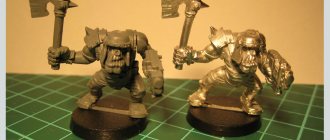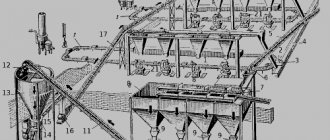Design features
Flat and shaped screwdrivers have one thing in common - the design of the tool. It consists of a round metal rod with a tip and a handle.
Kernel
Indicator screwdriver - how to use it correctly
The steel axis is the part that transmits the force of the hand from the handle to the tip of the screwdriver. The material for this is especially strong steel. Products differ in the length and thickness of the rods, the cross-section of which can be round or multifaceted.
Important! The rod can have different lengths, diameters and cross-sectional shapes. Standard length is 100-200 mm. The shaft is usually coated with nickel or chrome to protect against corrosion. The rods are also made of stainless steel.
Lever
This part is mainly made of plastic. The quality of the material affects the durability of the handle. Modern handles of high-quality products have non-slip rubberized inserts, a finger rest, and a large area for hand grip and palm rest.
Also at the bottom of the handle a transverse through hole is made to enhance torque. A rod is inserted through it to obtain additional force.
Professional OS on the handles have gel inserts that fit tightly to the palm, which ensures maximum transfer of force to the sting.
Sting
The effectiveness of the sting largely depends on the quality and strength of the tip material. Tips made from C-2 tool steel are considered high-quality and reliable tips. Particularly durable tips are made from molybdenum-vanadium alloy.
Flat head screwdriver
Profile Pz - main differences
In 1966, the same Phillips company modernized its earlier invention and introduced the Pozidrive slot - Pz (Pozidriv) to the world.
Its distinctive feature is:
1Additional edge located in the quarters of the slot.
The bit turns out to be 8-spline. Four main faces, four additional.
At the same time, the heads of self-tapping screws and screws received similar notches. All this allowed for even better centering of the tip.
2The edges of the working surface in Pz, unlike Ph, are made parallel to each other, and not at a narrowing angle.
With Ph, this taper is made specifically so that at the end of the twisting operation, the bit pops out of the head. The so-called self-pushing effect.
When Pz was invented, they abandoned this, shifting the responsibility of limiting the force to the screwdriver or torque tool itself.
3 Ph bits and screwdrivers have a slightly different sharpening angle - 50 degrees.
Thanks to all these modifications, the spline began to fit much deeper into the mounting hole of the fastener. Which led to increased tightening of self-tapping screws.
In simple words, we can say that Pz is a reinforced cross-shaped spline.
Markings and dimensions of a slotted screwdriver
Pulse soldering iron gun
Branded products have markings placed on the longitudinal surface or on the end of the handle. It meets the requirements of the international classification of hand tools. If you need a tool for household needs: unscrew and tighten screws, then you need to understand what the marking of the tool means: SL , PH , PZ :
- SL – regular flat spline;
- PH – Phillips screwdriver;
- PZ – the same with the presence of thin ray lines.
The marking can be in the form of a circle, inside which the pepper section of the tip is depicted. So, for example, flat screwdrivers are indicated by a stripe, Phillips screwdrivers - by a cross in a circle. All indicator instruments have a flat tip. Accordingly, shaped screwdrivers in the marking are displayed by the type of tip profile.
Hardware with various slot shapes
Around the circle, the manufacturer indicates the dimensions of the slot and the length of the rod. Marking with a circle with a stripe inside it. The dimensions of a slotted screwdriver are marked on the rim: 1.2 x 6.5 x 125 mm means that this is a flat screwdriver, designed to work with screws whose slots have dimensions of 1.2 x 6.5 mm, the length of the rod is 125 mm.
A marking with a cross containing the inscription PH 1 x 80 mm means a Phillips screwdriver of the following dimensions: 1 – fastener head diameter number, shaft length – 80 mm.
Cross School
Types of screwdrivers
Electrician's kit - what tools are included?
What types of screwdrivers there are can be represented by a fairly large list. You should consider popular and highly specialized types of screwdrivers.
Dielectric
To work with electrical equipment, use a dielectric screwdriver. It does not allow current up to 1000 V to pass through it. The entire instrument is covered with special plastic up to the tip. Electricians use such OSHs to work in electrical cabinets and switchboards.
Tool with dielectric coating
Reversible
The sonic screwdriver is equipped with ratcheting mechanisms. When the tip rotates, the ratchet makes a ratcheting sound. The tool can only rotate in one direction. To turn on the reverse mode, move the lever. Thanks to this device, the master tightens or unscrews the screw without removing the tip from the fastener slots. Reversible tools are otherwise called minus screwdrivers.
Reversible screwdriver
Hexagon
Hexagon-shaped screwdriver slots allow you to apply maximum force to the tool without fear of cutting off the edges of the tip or slots. Fasteners are used in places where the requirements for the strength of the connection of parts are especially high.
Star-shaped
Star-shaped splines are especially popular in the countries of the American continent. In European products for various purposes, star screws are quite common in electronic devices. Their use is subject to the same requirements as for hexagonal tips.
Square
A square-shaped slot is not found in everyday life. Hardware with square openings in the heads is used for mounting parts of special equipment, including in the defense industry.
U-shaped OS
Tools with double tips are called spanners. They are used in elevator facilities. The complex configuration of the tips is aimed at preventing incidents of vandalism in elevator cabins.
Fork
Similar to U-shaped screwdrivers, except that instead of two blades, they have a triple tip. This is a purely professional tool. Screws with such slots are not found in everyday life.
Triangular
Triangular screwdrivers are professional tools. Triangle screwdrivers are compatible with slotted screws that have a similar configuration. Triangular screwdrivers are used for opening and installing panels where access to cabinets and panels with electrical or other equipment is limited.
For One-way slot
The name One-way translated from English means “one way path”. Unscrewing hardware with such a head is only possible with a special tool. Any use of other types of tips results in cutting off the splines. The fastener resists unauthorized entry into various devices.
Bristol
The shape of the spline resembles a six-pointed gear. You can unscrew such hardware only with a Bristol tip. Otherwise, the slot is destroyed and the screw has to be drilled out. Hardware can be found in radio electronics service centers. They are used to protect against vandal penetration into devices.
For Torg-Set slot
The tip is made for a slot in the form of a cross with an offset center. Hardware with such splines is practically not found in Russia.
For muna Torx slot
Screwdrivers for this type of slot have a tip in the form of a six-pointed star. They are necessary in workshops where mobile phones and various gadgets are repaired.
For star spline
The star tip is designed for screws with six-pointed star slots. The stars have sharper peaks. The scope of application is the same as that of the previous type of tool.
It is important to distinguish between the last two types, because using PZ for screws with PH slots can damage the self-tapping screw. As a result, the fasteners will have to be drilled out, and the screwdriver itself will fail.
Splines and tips
Note! If you have to deal with soured hardware, use an impact screwdriver. It is equipped with a thick metal cap at the end of the handle that can withstand hammer blows. When struck, the tip of the tool rotates with powerful force.
How to choose a screwdriver
In order for the tool to serve for a long time and be comfortable to use, it is important to make the right choice of product. You need to understand what the OS will be used for.
Disassembling or installing parts of small devices will require the use of precision screwdrivers. They are used to disassemble or assemble watches, mobile phones, and the like.
For quick installation or disassembly of facing materials, furniture and other things, it is better to use an OS with a ratchet mechanism. A ratchet is a mechanism that allows the tool tip to rotate in only one direction. Such devices are equipped with a reversing device that changes the working stroke of the screwdriver clockwise and vice versa.
Products with a set of removable tips allow you to save on the purchase of tools with different tips. Stings can be purchased as needed. All handles and removable rod ends are compatible, regardless of their manufacturer. The set with interchangeable tips, shown in the bottom photo, allows you to quickly replace the tip with another tip.
Set of removable tips
Additional Information. When choosing a screwdriver, you need to pay attention to the quality of the plastic and the ergonomics of the handle. The quality of the metal from which the tip is made matters. The best material for this is chrome vanadium steel.
Screwdriver selection methods
To determine the type of tool, study the work tasks and the type of fasteners to be worked with. The quality of a screwdriver is shown by the following parameters indicated on the case and in technical documents:
- strength is marked on the case, choose an indicator in the range of 45–50 units for purchase. Lower values indicate the likelihood of bending during operation, higher values indicate the likelihood of cracking;
- It is preferable to select the manufacturing material from an alloy of vanadium and chromium (Cr-V);
- the package should include a rubber coating for grip in the hand, and removable bits should be purchased with magnetic coating so that small fastening hardware is not lost;
- the body must be marked with compliance with GOST 17199–1988 (for Russian manufacturers).
The screwdriver must be used correctly and used for specific purposes, only in this case the tool will last a long time.
Operation of screwdrivers
To operate the OS correctly, you must adhere to several rules:
- In the marking of products, according to GOST, the type of slot is encrypted (see the chapter “Marking” above). The screwdriver must be used in full accordance with the type and size of the slot;
- It is better to store the tool in a suspended state. In this case, the tips will be protected from accidental damage;
- Clean instruments are stored in dry indoor conditions that do not provoke metal corrosion.
Self-production
You can make a screwdriver from any metal rod or nail. The rod is ground on a grinding machine on one side. Usually they make a tool with a tip for a straight slot.
Home craftsmen grind a head with an opening for replacement bits. It is welded to the end of the rod. The end of the rod on the other side is bent with a hook. You can use an old key for the blank. This is convenient because the tool can be carried on a key ring.
For a homemade cross OSH you will need a milling machine and a sharpener. The tip of the rod is milled, achieving a cruciform cross-section of the rod. Then the finished tip is ground into a cone shape.
An L-shaped fold is placed between the cut halves of a round block. Then both pieces are tightened with clamps. In another case, the bent end of the rod is placed in a mold and filled with epoxy resin. The handle is then ground down for comfortable hand grip.
The correct selection of slotted screwdrivers facilitates quick and efficient repair and installation of various devices and instruments with threaded connections. You can easily purchase suitable hand tools in the retail chain.
Non-standard applications
It happens that you need to tighten something in a hard-to-reach place where only the shaft of a screwdriver can get through. And there is no special tool at hand that can hold the fastener. Then you have to resort to such a trick as magnetizing the tip. Then the bolt or screw will be easily held on the tip, which will allow you to deliver it and tighten it anywhere. The following steps will show you how to magnetize a screwdriver at home:
Using a magnet. A powerful magnet, preferably neodymium, is suitable for this. The stronger the magnet, the better the magnetization effect. You can buy the necessary magnet at the market or at a hardware store. If you have old computer hard drives at home, you can use the magnets in them. For proper magnetization, it is necessary to clean the surface of the rod from contamination and dry the surface after processing. Then you need to take the magnet and move it along the shaft of the tool from the handle to the tip, you need to do this several times, then turn the tool a quarter turn and do the same with each side. You only need to move the magnet in one direction. If, after completing the procedure, the tool is not able to hold the fastener, then the entire process must be repeated again. In case of repeated failure, it is worth replacing the magnet with a more powerful one. A tool made of good steel can hold magnetic domains for up to several months. If the tool needs to be demagnetized, then you can carry out the same procedure, but in the direction from the tip to the handle, or knock the tool on the floor or wall, which will help destroy the magnetic domains. Using a battery. For this method, you will need a small cross-section electrical wire with a length of at least one meter and ends stripped on both sides. A 2.5 square wire with single insulation is best suited. The ends of the wire are stripped, and the remaining unstripped part is wound around the screwdriver rod, thus forming a kind of magnetic field. Then take a battery or crown with a power of 6 to 9 volts (no less and no more), to which the stripped ends of the wire are connected. There is no difference where to connect the negative and positive contacts
It is important to know that it usually takes half to one minute for the tool to become fully magnetized. After this time has expired, the battery must be disconnected from the wires, the tool must be released and placed on the mount.
If magnetization is unsuccessful, you can try to increase the number of skeins, placing them in two layers on top of each other. Increasing the battery power can also help, but you should be wary of electric shock or sparks, so all manipulations should be carried out with dielectric gloves. There are also several options for magnetizing the instrument, which would most likely be considered amateur. You can magnetize the instrument using a silk scarf or synthetic rag. If you carefully rub the tip with a similar cloth for a long time, then for some period of time, the screwdriver will be able to hold a small bolt or screw. If you don’t have anything on hand that can magnetize the tool, you can use a hammer or a heavy wrench. To do this, you need to position the tool with the tip facing north and hit the tip for a long time. Thus, the magnetic domains are aligned in the direction of the Earth's magnetic field.
During all manipulations, it is necessary to adhere to certain rules so that neither the human body nor the instrument itself is damaged. When using a neodymium magnet, you should remember that it has a very powerful attractive force and can pinch part of the skin. All actions must be carried out wearing special dielectric gloves.
